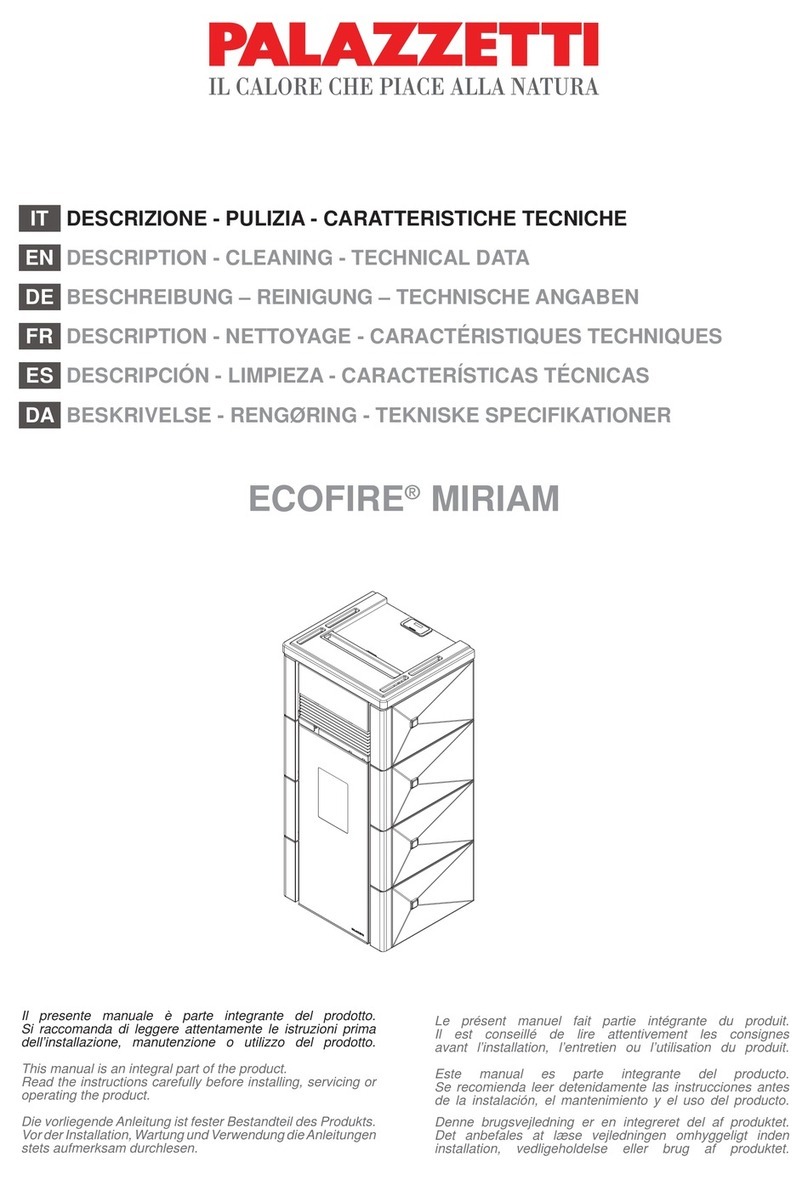
4
ENGLISH
SAFETY INFORMATION
• The product is not designed for use by people,
including children, with limited physical, sensory
and mental abilities.
• The appliance is not designed for cooking
purposes.
• The appliance is designed to burn UNI EN ISO
17225-2 category A1 wood pellets, in the amounts
and manner described in this manual.
• The appliance is designed for indoor use and in
areas with normal humidity conditions.
• Keep the product in a dry place out of the weather.
• For the legal and company warranties, refer to the
warranty certificate inside the product: specifically,
neither the manufacturer nor the dealer are liable
for damage resulting from incorrect installation or
maintenance.
Safety risks may be caused by:
• installation in unsuitable conditions. In particular,
conditions of fire hazard. DO NOT INSTALL THE
PRODUCT IN AREAS SUBJECT TO THE RISK OF
FIRE.
• contact with fire and hot parts (e.g. glass panel
and pipes). DO NOT TOUCH HOT PARTS and,
when the boiler stove is switched off and still hot,
always wear the gloves supplied.
• contact with live electrical equipment (internal).
DO NOT ACCESS THE INTERNAL ELECTRICAL
EQUIPMENT WHILE THE APPLIANCE IS
POWERED ON. Electrocution hazard.
• use of improper ignition aids (e.g. alcohol). DO
NOT IGNITE OR BOOST THE FLAME WITH FLUID
SPRAYS OR A FLAME TORCH. Serious risk of
burns, damage and injury.
• use of fuel other than wood pellets. DO NOT
BURN WASTE MATTER, PLASTIC OR OTHER
MATERIALS THAN WOOD PELLETS IN THE
HEARTH. The product may become soiled, the
flue may catch fire, and environmental damage
may ensue.
• cleaning the hearth when hot. DO NOT CLEAN
THE HEARTH WITH A VACUUM CLEANER WHILE
IT IS HOT. Risk of damage to the cleaner and
smoke in the room.
• cleaning the fumes duct with cleaning products. DO
NOT CLEAN THE PRODUCT WITH FLAMMABLE
PRODUCTS. Risk of fire or blowback.
• cleaning the hot glass pane with unsuitable
cleaning products. DO NOT CLEAN HOT GLASS
WITH WATER. ONLY USE RECOMMENDED
GLASS CLEANING PRODUCTS. Risk of cracking
and permanent, irreparable damage to the glass.
• the storage of flammable materials at a distance
which is less than the safe distances listed in
this manual. DO NOT PLACE LAUNDRY ON
THE APPLIANCE. DO NOT PLACE DRYING
RACKS WITHIN THE SAFETY CLEARANCE. Keep
flammable fluids away from the appliance. Fire
hazard.
• blocking the aeration vents and air intakes in the
room. DO NOT BLOCK THE AERATION VENTS
OR FLUE. Risk of smoke returning into the room
with consequent damage and injury.
• use of the product as a support or ladder. DO NOT
CLIMB ONTO THE PRODUCT OR USE IT AS A
SUPPORT. Risk of damage and injury.
• use of the boiler stove with the hearth open. DO
NOT USE THE PRODUCT WITH ITS DOOR OPEN.
• incandescent material projected from the open
door. DO NOT throw incandescent material
outside the appliance. Fire hazard.
• use of water in case of fire. CALL THE AUTHORITIES
if a fire breaks out.
• The appliance must never be used without water
in the system; any “dry” lighting is likely to damage
the appliance.
If you have doubts, please do not take any action, but
contact the retailer or the installer.
For reasons of safety, read the user instructions
included in this manual.




























